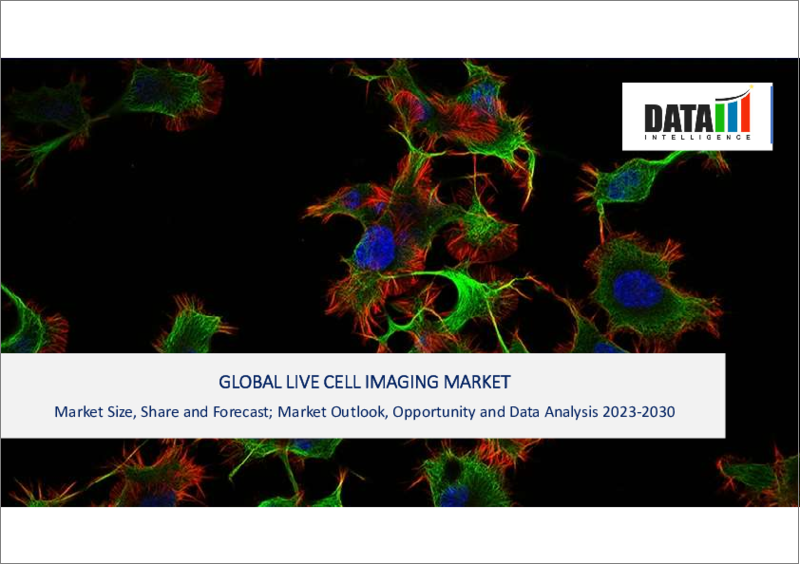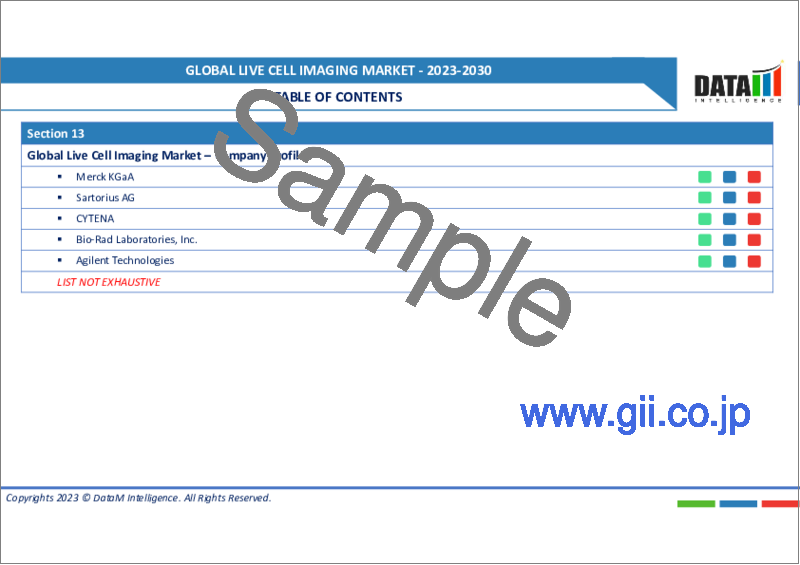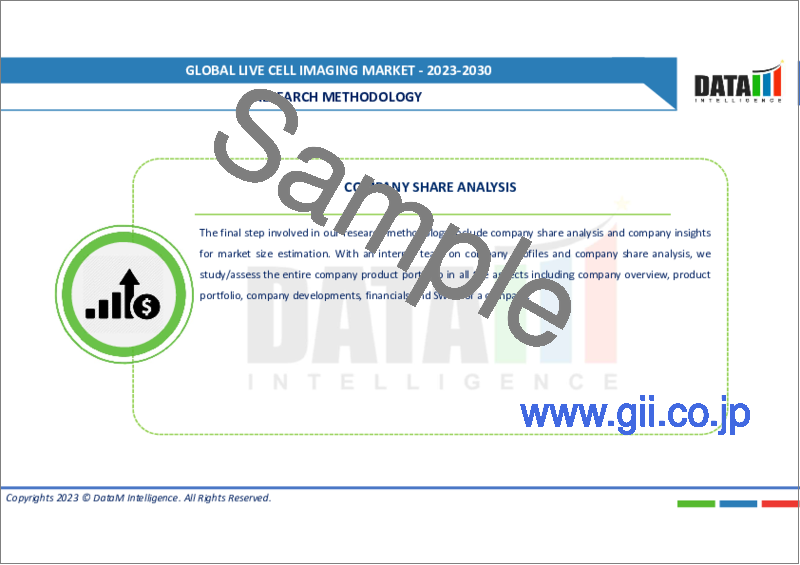|
|
市場調査レポート
商品コード
1129280
ライブセルイメージングの世界市場-2022-2029Global Live Cell Imaging Market - 2022-2029 |
||||||
|
● お客様のご希望に応じて、既存データの加工や未掲載情報(例:国別セグメント)の追加などの対応が可能です。 詳細はお問い合わせください。 |
|||||||
| ライブセルイメージングの世界市場-2022-2029 |
|
出版日: 2022年09月29日
発行: DataM Intelligence
ページ情報: 英文 180 Pages
納期: 約2営業日
|
- 全表示
- 概要
- 目次
市場力学
細胞生物学を研究するためのライブセルイメージングを撮影する新技術の開拓が、市場成長の原動力になると予想されます。
香港科学技術大学(HKUST)の研究者は、3Dライブセルムービーを撮影し、かなり高い品質の画像を生成する新世代の顕微鏡を開発し、細胞生物学の研究の精度と範囲を大幅に向上させました。一方、HKUSTのDu Shengwang教授とMichael Loy教授が率いるチームが開発したLiTone Line Bessel Sheet(LBS)顕微鏡は、現在の共焦点型に比べて光毒性が1000分の1であり、細胞をはるかに長時間観察することが可能です。さらに、広範な科学と工学に基づいた強力な技術ですが、専門知識の少ない生物学者でも使えるように、ユーザー向けに簡略化しています。そうすれば、やがてある種の病気がどのように形成され、発症したのかという謎を、科学者が細胞レベルで解き明かすことができるようになるかもしれません。したがって、上記の記述から、予測期間中に市場を牽引することが期待されます。
制約事項
高度なライブセルイメージング技術や装置は高価であり、熟練した専門家の不足、装置やソフトウェアの種類に対する政府の厳しい承認が、予測期間中に市場が阻害されるいくつかの要因であると考えられます。
産業分析
ライブセルイメージング市場は、サプライチェーン分析、償還シナリオ、価格分析など、様々な業界要因に基づいた市場の詳細な分析を提供します。
COVID-19の影響分析
COVID-19のパンデミックは、ヘルスケアシステムと市場に中程度の影響を及ぼしています。COVID-19の研究者は、研究室に入ることなくウイルスに感染した細胞を監視・調査するために、遠隔ライブセルイメージングを採用しています。これにより、時間が節約され、COVID-19研究に伴うリスクが軽減されます。SARS-CoV-2細胞の入り口を調べるための現在のセルベースアッセイは、実際のウイルスまたはスパイクを持つ疑似型付けウイルスを使用しますが、これは時間がかかり、バイオセーフティ施設と多段階の実験技術を必要とします。このため、関連する研究、特にハイスループットなスクリーニング実験に大きな支障をきたしていました。複数の研究者が、抗体およびワクチン開発をサポートするウイルスフリー環境において、SARS-CoV-2侵入阻害剤をハイスループットにスクリーニングする理想的なシステムを実現するために、ライブセルイメージングを用いて可視化および定量化が可能な蛍光SARS-CoV-2侵入プローブを開発しました。COVID-19を産生するウイルスであるSARS-CoV-2は、世界中の研究者によって研究されています。研究者は、ウイルス研究中に、高度な顕微鏡装置などのライブセルイメージング法を利用して、細胞活動を分析することができます。ウイルス学に基づく研究では、ワクチン接種を行うために膨大なデータを処理する必要があります。
一方、パンデミックでは、サプライチェーンとプロセスが中断されます。多くの企業は、製品の入手可能性を確保し、サプライチェーンを保護するために、他の地域へと変化していきます。したがって、上記の文から、市場は影響を受け、それは経済活動の再開と迅速にトラクションを得ることが期待されるようになっています。
世界のライブセルイメージング市場レポートでは、約45+市場データ表、40+図、180ページの構成で提供しています。
目次
第1章 調査手法と調査範囲
- 調査手法
- 調査目的および調査範囲
第2章 市場の定義と概要
第3章 エグゼクティブサマリー
第4章 市場の力学
- 市場影響要因
- 促進要因
- 細胞生物学研究のためのライブセルイメージを撮影する新技術の開拓が、市場成長の原動力になると予想されます。
- 抑制要因
- 熟練した専門家の不足と、機器の種類に対する政府の厳しい承認が、市場成長の妨げになると予想されます。
- 市場機会
- 影響分析
- 促進要因
第5章 産業分析
- サプライチェーン分析
- 価格設定分析
- アンメットニーズ分析
- パイプライン分析
第6章 COVID-19の分析
- COVID-19の市場分析
- COVID-19以前の市場シナリオ
- COVID-19の現在の市場シナリオ
- COVID-19の後、または将来のシナリオ
- COVID-19の中での価格ダイナミクス
- 需要-供給スペクトラム
- パンデミック時の市場に関連する政府の取り組み
- メーカーの戦略的な取り組み
- まとめ
第7章 製品タイプ別
- 機器
- スタンドアローンシステム
- マイクロスコープ
- セルアナライザー
- 画像撮影装置
- その他
- 消耗品
- 試薬・キット
- その他
- ソフトウェア
- その他
第8章 技術別
- 光退色後の蛍光回復法
- 蛍光共鳴エネルギー移動法
- ハイコンテンツ解析
- 蛍光in situハイブリダイゼーション
- その他
第9章 アプリケーション別
- 創薬
- 細胞生物学
- 発生生物学
- 幹細胞
- その他
第10章 エンドユーザー別
- 製薬会社、バイオテクノロジー企業
- 診断研究所
- 病院
- 学術・研究機関
- その他
第11章 地域別
- 北米
- 米国
- カナダ
- メキシコ
- 欧州
- ドイツ
- 英国
- フランス
- イタリア
- スペイン
- その他欧州
- 南米
- ブラジル
- アルゼンチン
- その他の南米地域
- アジア太平洋地域
- 中国
- インド
- 日本
- オーストラリア
- その他アジア太平洋地域
- 中東・アフリカ地域
第12章 競合情勢
- 主な展開と戦略
- 企業シェア分析
- 製品ベンチマーク
- 注目の主要企業リスト
第13章 企業プロファイル
- PerkinElmer Inc.
- 企業概要
- 製品ポートフォリオと説明
- 主なハイライト
- 財務概要
- Live Cell Instruments
- Zeiss Group
- Axion BioSystems, Inc
- Becton, Dickinson and Company
- CYTENA
- Thermo Fisher Scientific
- Bio-Rad Laboratories, Inc.
- Agilent Technologies
- Cytiva
第14章 ライブセルイメージングの世界市場-DataM
Market Overview
Live Cell Imaging Market size was valued US$ YY million in 2021 and is estimated to reach US$ YY million by 2029, growing at a CAGR of 8.8 % during the forecast period (2022-2029).
Live-cell imaging has revolutionized how scientists study cells, proteins, various processes and complicated molecular interactions. Using live-cell imaging techniques, researchers may view cell shapes and functions in real-time and over time. Instead of simply presenting an image of a cell's current state, live-cell imaging enables the visualization and characterization of dynamic cellular events and processes in real-time. Exploring dynamic processes, viewing the localization and mobility of particular molecules, and analyzing structural aspects of a cell are some of the most important uses of live cell imaging. Furthermore, live-cell imaging techniques enable scientists to monitor the physiological integrity of cells and other cellular and molecular processes such as exocytosis, signal transduction, enzyme activity, and protein trafficking.
Market Dynamics
The development of new technology to capture live cell images to study cell biology is expected to drive market growth.
Researchers at The Hong Kong University of Science and Technology (HKUST) have developed a new generation of microscopes that captures 3D live-cell movies and produces considerably higher quality images, greatly improving the accuracy and scope of cell biology research. The LiTone Line Bessel Sheet (LBS) microscope developed by a team led by Prof Du Shengwang and Prof Michael Loy from HKUST, on the other hand, is 1,000 times less photo-toxic than the present confocal model, allowing the cell to be observed for much longer. Moreover, it is a powerful technology based on extensive science and engineering, but we simplify it for users so that biologists with little expertise may use it. That could eventually help scientists unlock the mystery of how certain diseases were formed and developed at a cellular level. Thus, from the above statements, the market is expected to drive in the forecast period.
Restraint:
Advanced live-cell imaging technology and equipment are expensive, lack of skilled professionals and stringent government approvals for types of equipment and software are some factors the market is expected to get hampered in the forecast period.
Industry Analysis
The live cell imaging market provides in-depth analysis of the market based on various industry factors such as supply chain analysis, reimbursement scenario, pricing analysis etc.
COVID-19 Impact Analysis
The COVID-19 pandemic has moderately impacted healthcare systems and the market. COVID-19 researchers employ remote live-cell imaging to monitor and investigate virus-infected cells without entering the lab. This saves time and reduces the risks involved with the COVID-19 study. Current cell-based assays for examining SARS-CoV-2 cell entrance involve either an actual virus or spike-bearing pseudotyping viruses, which is time-consuming and necessitates biosafety facilities and multistep experimental techniques. This has significantly hampered relevant investigations, particularly high-throughput screening experiments. Several researchers have developed a fluorescent SARS-CoV-2 entry probe that can be visualized and quantified using live-cell imaging to implement an ideal system for high-throughput screening SARS-CoV-2 entry inhibitors in virus-free environments supporting antibody and vaccine development. SARS-CoV-2, the virus that produces COVID-19, is being studied by several worldwide researchers. Researchers can utilize live-cell imaging methods, such as advanced microscopy equipment, during the viral study to analyze cellular activities. Virology-based research necessitates the processing of vast amounts of data to generate vaccinations.
In contrast, the pandemic interrupts the supply chain and process. Many companies will vary to other geographic regions to ensure that products remain available and protect their supply chain. Thus, from the above statements, the market got affected, and it is expected to gain traction quickly with the resumption of economic activities.
Segment Analysis
Equipment segment is expected to hold the largest market share in live cell imaging market
The equipment segment is expected to dominate in 2021. The segment is further sub-segmented into standalone systems, microscopes, cell analyzers, and image capturing devices. In this, Equipment or devices that can function independently of other hardware and are not integrated into another device are called standalone systems. The extensive use of these systems in live-cell imaging and the rising emphasis on research and technological development are the primary reasons driving the segment's growth. Moreover, according to a February 2022 update, TGen and Deepcell partnered to classify and isolate sick cells using artificial intelligence-based technology. Deepcell's AI-powered technology transforms cell morphology into a quantitative and high throughput marker for use in research and a novel independent way to supplement existing molecular procedures. Thus, from the above statements, the market segment is expected to hold the largest market share in the forecast period.
Geographical Analysis
North America region holds the largest market share in the global live cell imaging market
In 2021, North America accounted for the highest revenue share. The rising geriatric population, significant commitment and funding available for live-cell imaging research, high adoption of innovative treatments, the presence of large pharmaceutical corporations and prominent research institutes, as well as their active involvement in the development and commercialization of novel, enhanced live-cell imaging systems in the region are some of the factors the market is expected to boost in the forecast period. For instance, PHC Corporation of North America announced cooperation with SCREEN Holdings Co., Ltd. on September 21, 2021, to market and distributed the SCREEN Cell3iMager family of live-cell imaging equipment in North America. Moreover, biopharmaceutical companies invested more than a trillion dollars in research and development over the last decade, including a record-breaking year in 2020, when PhRMA member companies invested approximately USD 91 billion in research and development. Thus, from the above statements, the North American region is expected to hold the largest market share in the forecast period.
Competitive Landscape
Major key players in the live cell imaging market are PerkinElmer Inc, Live Cell Instruments, Zeiss Group, Axion BioSystems, Inc, Becton, Dickinson and Company, CYTENA, Thermo Fisher Scientific, Bio-Rad Laboratories, Inc., Agilent Technologies , Cytiva.
PerkinElmer Inc.:
Overview:
PerkinElmer is a leading, global provider of end-to-end solutions that help scientists, researchers, and clinicians better diagnose disease, discover new and more personalized drugs, monitor the safety and quality of our food, and drive environmental and applied analysis excellence. The company has a dedicated team of more than 16,000 and collaborates closely with commercial, government, academic, and healthcare customers to deliver reagents, assays, instruments, automation, informatics, and strategic services that accelerate workflows, deliver actionable insights, and support improved decision making. The company serves customers in 190 countries and is a component of the S&P 500 index.
Product Portfolio:
MuviCyte Live-Cell Imaging Kit: The MuviCyte live-cell imaging system works inside your cell-culture incubator, allowing you to keep your cells in ideal conditions while performing various experiments in different culture containers. The MuviCyte live-cell imaging package includes a live-cell imaging apparatus as well as 4x, 10x, and 20x objective lenses, a PC, and a monitor.
The global live cell imaging market report would provide an access to an approx. 45+market data table, 40+figures and 180pages.
Table of Contents
1. Methodology and Scope
- 1.1. Research Methodology
- 1.2. Research Objective and Scope of the Report
2. Market Definition and Overview
3. Executive Summary
4. Market Dynamics
- 4.1. Market Impacting Factors
- 4.1.1. Drivers
- 4.1.1.1. The development of new technology to capture live cell images to study cell biology is expected to drive market growth.
- 4.1.2. Restraints:
- 4.1.2.1. Lack of skilled professionals and stringent government approvals for types of equipment are expected to hamper the market growth.
- 4.1.3. Opportunity
- 4.1.4. Impact Analysis
- 4.1.1. Drivers
5. Industry Analysis
- 5.1. Supply Chain Analysis
- 5.2. Pricing Analysis
- 5.3. Unmet Needs
- 5.4. Pipeline Analysis
6. COVID-19 Analysis
- 6.1. Analysis of Covid-19 on the Market
- 6.1.1. Before COVID-19 Market Scenario
- 6.1.2. Present COVID-19 Market Scenario
- 6.1.3. After COVID-19 or Future Scenario
- 6.2. Pricing Dynamics Amid Covid-19
- 6.3. Demand-Supply Spectrum
- 6.4. Government Initiatives Related to the Market During Pandemic
- 6.5. Manufacturers Strategic Initiatives
- 6.6. Conclusion
7. By Product Type
- 7.1. Introduction
- 7.1.1. Market Size Analysis, and Y-o-Y Growth Analysis (%), By Product Type
- 7.1.2. Market Attractiveness Index, By Product Type Segment
- 7.2. Equipment
- 7.2.1. Standalone Systems
- 7.2.2. Microscopes
- 7.2.3. Cell Analyzers
- 7.2.4. Image Capturing Devices
- 7.2.5. Others
- 7.2.6. Introduction
- 7.2.7. Market Size Analysis, US$ Million, 2020-2029 and Y-o-Y Growth Analysis (%), 2021-2029
- 7.3. Consumables
- 7.3.1. Reagents and Kits
- 7.3.2. Others
- 7.4. Software
- 7.5. Others
8. By Technology
- 8.1. Introduction
- 8.1.1. Market Size Analysis, and Y-o-Y Growth Analysis (%), By Technology
- 8.1.2. Market Attractiveness Index, By Technology Segment
- 8.2. Fluorescence Recovery After Photobleaching*
- 8.2.1. Introduction
- 8.2.2. Market Size Analysis, US$ Million, 2020-2029 and Y-o-Y Growth Analysis (%), 2021-2029
- 8.3. Fluorescence Resonance Energy Transfer
- 8.4. High-content Analysis
- 8.5. Fluorescence In Situ Hybridization
- 8.6. Others
9. By Application
- 9.1. Introduction
- 9.1.1. Market Size Analysis, and Y-o-Y Growth Analysis (%), By Application
- 9.1.2. Market Attractiveness Index, By Application Segment
- 9.2. Drug Discovery*
- 9.2.1. Introduction
- 9.2.2. Market Size Analysis, US$ Million, 2020-2029 and Y-o-Y Growth Analysis (%), 2021-2029
- 9.3. Cell Biology
- 9.4. Developmental Biology
- 9.5. Stem Cells
- 9.6. Others
10. By End user
- 10.1. Introduction
- 10.1.1. Market Size Analysis, and Y-o-Y Growth Analysis (%), By End user
- 10.1.2. Market Attractiveness Index, By End user Segment
- 10.2. Pharmaceutical and Biotechnology Companies*
- 10.2.1. Introduction
- 10.2.2. Market Size Analysis, US$ Million, 2020-2029 and Y-o-Y Growth Analysis (%), 2021-2029
- 10.3. Diagnostic Laboratories
- 10.4. Hospitals
- 10.5. Academic and Research Institutes
- 10.6. Others
11. By Region
- 11.1. Introduction
- 11.1.1. Market Size Analysis, US$ Million, 2020-2029 and Y-o-Y Growth Analysis (%), 2021-2029, By Region
- 11.1.2. Market Attractiveness Index, By Region
- 11.2. North America
- 11.2.1. Introduction
- 11.2.2. Key Region-Specific Dynamics
- 11.2.3. Market Size Analysis, and Y-o-Y Growth Analysis (%), By Product Type
- 11.2.4. Market Size Analysis, and Y-o-Y Growth Analysis (%), By Technology
- 11.2.5. Market Size Analysis, and Y-o-Y Growth Analysis (%), By Application
- 11.2.6. Market Size Analysis, and Y-o-Y Growth Analysis (%), By End user
- 11.2.7. Market Size Analysis, and Y-o-Y Growth Analysis (%), By Country
- 11.2.7.1. U.S.
- 11.2.7.2. Canada
- 11.2.7.3. Mexico
- 11.3. Europe
- 11.3.1. Introduction
- 11.3.2. Key Region-Specific Dynamics
- 11.3.3. Market Size Analysis, and Y-o-Y Growth Analysis (%), By Product Type
- 11.3.4. Market Size Analysis, and Y-o-Y Growth Analysis (%), By Technology
- 11.3.5. Market Size Analysis, and Y-o-Y Growth Analysis (%), By Application
- 11.3.6. Market Size Analysis, and Y-o-Y Growth Analysis (%), By End user
- 11.3.7. Market Size Analysis, and Y-o-Y Growth Analysis (%), By Country
- 11.3.7.1. Germany
- 11.3.7.2. U.K.
- 11.3.7.3. France
- 11.3.7.4. Italy
- 11.3.7.5. Spain
- 11.3.7.6. Rest of Europe
- 11.4. South America
- 11.4.1. Introduction
- 11.4.2. Key Region-Specific Dynamics
- 11.4.3. Market Size Analysis, and Y-o-Y Growth Analysis (%), By Product Type
- 11.4.4. Market Size Analysis, and Y-o-Y Growth Analysis (%), By Technology
- 11.4.5. Market Size Analysis, and Y-o-Y Growth Analysis (%), By Application
- 11.4.6. Market Size Analysis, and Y-o-Y Growth Analysis (%), By End user
- 11.4.7. Market Size Analysis, and Y-o-Y Growth Analysis (%), By Country
- 11.4.7.1. Brazil
- 11.4.7.2. Argentina
- 11.4.7.3. Rest of South America
- 11.5. Asia Pacific
- 11.5.1. Introduction
- 11.5.2. Key Region-Specific Dynamics
- 11.5.3. Market Size Analysis, and Y-o-Y Growth Analysis (%), By Product Type
- 11.5.4. Market Size Analysis, and Y-o-Y Growth Analysis (%), By Technology
- 11.5.5. Market Size Analysis, and Y-o-Y Growth Analysis (%), By Application
- 11.5.6. Market Size Analysis, and Y-o-Y Growth Analysis (%), By End user
- 11.5.7. Market Size Analysis, and Y-o-Y Growth Analysis (%), By Country
- 11.5.7.1. China
- 11.5.7.2. India
- 11.5.7.3. Japan
- 11.5.7.4. Australia
- 11.5.7.5. Rest of Asia Pacific
- 11.6. Middle East and Africa
- 11.6.1. Introduction
- 11.6.2. Key Region-Specific Dynamics
- 11.6.3. Market Size Analysis, and Y-o-Y Growth Analysis (%), By Product Type
- 11.6.4. Market Size Analysis, and Y-o-Y Growth Analysis (%), By Technology
- 11.6.5. Market Size Analysis, and Y-o-Y Growth Analysis (%), By Application
- 11.6.6. Market Size Analysis, and Y-o-Y Growth Analysis (%), By End user
12. Competitive Landscape
- 12.1. Key Developments and Strategies
- 12.2. Company Share Analysis
- 12.3. Product Benchmarking
- 12.4. List of Key Companies to Watch
13. Company Profiles
- 13.1. PerkinElmer Inc.*
- 13.1.1. Company Overview
- 13.1.2. Product Portfolio and Description
- 13.1.3. Key Highlights
- 13.1.4. Financial Overview
- 13.2. Live Cell Instruments
- 13.3. Zeiss Group
- 13.4. Axion BioSystems, Inc
- 13.5. Becton, Dickinson and Company
- 13.6. CYTENA
- 13.7. Thermo Fisher Scientific
- 13.8. Bio-Rad Laboratories, Inc.
- 13.9. Agilent Technologies
- 13.10. Cytiva
LIST NOT EXHAUSTIVE
14. Global Live Cell Imaging Market - DataM
- 14.1. Appendix
- 14.2. About Us and Applications
- 14.3. Contact Us




